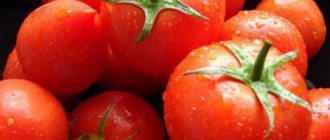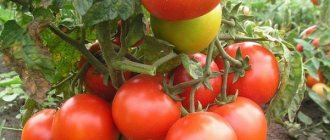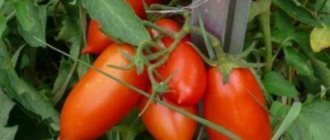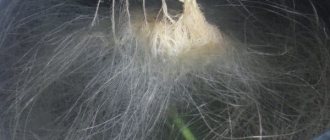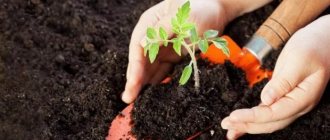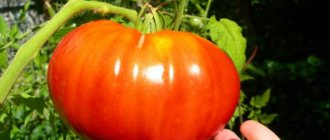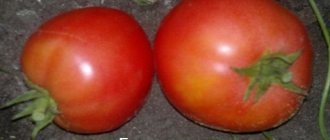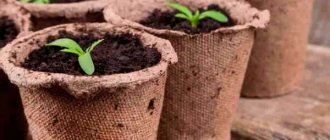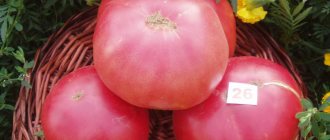Tomato Tsar Bell was created in Russia. This is a variety of large, juicy and fleshy tomatoes, which are not at all difficult to grow, and the harvest will please even the most demanding gardeners and connoisseurs.
| Height | Landing location | Ripening time | Fruit color | Fruit size | Origin | Fruit shape |
| Medium height | Greenhouse, Open ground | Mid-early | Reds | Large | Variety | Heart-shaped |
Description and characteristics of the variety
Tsar Bell tomato bushes belong to the semi-determinate type, their average height is 75-100 cm, but can grow up to 1.3 m. The leaves are dark green, dense, the bush is medium leafy. In terms of timing, the variety is mid-early, although in catalogs it can be classified as both early and mid-ripening. From germination of crops to the first harvest, approximately 100-110 days pass.
The tomatoes are large, weighing on average 250-550 g, and specimens up to 800 g grow on the lower racemes. They are red in color, heart-shaped, tapering downward. The pulp is juicy, with a sweetish and sour taste. Suitable for fresh consumption, processing into juices and purees, and preparing vegetable dishes. It is difficult to preserve whole, but it can be included in cuts.
The pulp is tender and does not overload the stomach, which allows it to be used for dietary dishes. Contains beta-carotene.
Landing
The variety is recommended for growing under film, in light greenhouses, and also in open ground. It is best to plant tomatoes after cabbage, cucumbers, legumes and herbs. For 1 sq. m. It is not recommended to plant more than 2-3 bushes.
It is important to timely weed, loosen the soil and periodically fertilize the plants (3-4 times per season). Watering should be regular and moderate.
Form a plant with 2-3 stems. The remaining stepsons need to be cut off.
Growing seedlings
Planting seeds for seedlings should be done in March. It is important to pre-soak them in a growth stimulator. The soil should be light and loose. It is best if it consists of equal parts of turf soil, humus and river sand.
Do not bury the seeds too deep into the ground. They should be planted at a maximum depth of 1.5-2.0 cm. After this, moisten the soil with a spray bottle. The best temperature for germination is +25 degrees.
After the emergence of seedlings, it is recommended to lower the ambient temperature, and add as much light as possible so that the seedlings do not stretch out and the stems are not thin.
When the young sprouts already have 1-2 leaves, you should pick them after abundant watering. But this is the case if the seedlings were sown densely in a common container. If peat tablets, pots or special forms for seedlings were used, then this step is not needed.
Grown seedlings must be hardened off so that they do not get sick or wither after being planted in the ground. This should be done over a period of 14 days by taking containers with tomatoes out onto the balcony or terrace every day for several hours.
Landing in the ground
It is recommended to plant seedlings in a permanent place in open ground or in a greenhouse at the age of approximately 60 days. This should not be done earlier than the end of May, beginning of June. It is important that the soil is already well warmed up and the threat of night frosts has passed.
Bushes are planted at a distance of 40 cm. And between the rows there are gaps of 60 cm. It is best to arrange the tomatoes in a checkerboard pattern, then they will have enough lighting. Tomatoes are planted in the ground by transshipment, that is, together with a lump of earth, so that the root system is not disturbed. After this, it is important to water them immediately.
Be sure to immediately dig a peg for tying near each bush when planting. If everything is done correctly and good care is provided, the harvest will certainly be high. During the season, from each square meter you can get up to 18 kg of selected large tomatoes.
Growing seedlings
The key to a bountiful harvest is high-quality seed material. It is purchased from trusted sellers who can present quality certificates.
Close attention is paid to the appearance of the packaging. It must be intact, it must indicate the expiration date and a description of the method of growing tomatoes.
Seed preparation
Purchased seed is disinfected by placing it in a 1% solution of potassium permanganate for 30 minutes.
If the seeds are bright in color, then no additional processing is needed; they are already disinfected and kept in a nutrient.
Tomato seeds are placed on wet gauze and left for several days.
Sowing scheme
Seeds for seedlings begin to be sown in March or April, which depends on the climatic characteristics of a particular region.
Tomatoes are grown in light soil, which you buy or make yourself, mixing turf soil, river sand and old humus (1:1:1).
Before use, the soil mixture is steamed to prevent contamination of the seeds by pathogenic organisms.
The prepared container (no deeper than 15 cm) is filled with soil, furrows (1.5-2 cm) are drawn with a pencil and the seeds are sown. Cover the top with a layer of peat, spray with water from a spray bottle, cover with film and send to a warm place (25°).
When the first shoots appear, the film is removed and the container is placed on a well-lit windowsill. It is recommended to lower the temperature by several degrees and water as needed.
When 2-3 true leaves appear, seedlings are picked into peat pots. 2-3 weeks before planting in a permanent place, the plants are hardened, gradually increasing the time in the fresh air from 30 minutes to 8 hours.
Characteristics
Russian variety of amateur selection. Recommended for growing in open ground, light greenhouses and under film. Productivity is high, up to 18 kg per square meter. The fruits store well; tomatoes collected at technical ripeness ripen at room temperature.
In the table below you can see what the yield of other tomato varieties is:
| Variety name | Productivity |
| The Tsar Bell | up to 18 kg per square meter |
| Grandma's gift | up to 6 kg per bush |
| Brown sugar | 6-7 kg per square meter |
| Premier | 6-9 kg per square meter |
| Polbig | 3.8-4 kg per bush |
| Black bunch | 6 kg per bush |
| Kostroma | 4.5-5 kg per bush |
| Red bunch | 10 kg per bush |
| Lazy | 15 kg per square meter |
| Doll | 8-9 kg per square meter |
Tomatoes variety Tsar Bell - table type, used for preparing hot dishes, soups, sauces, purees and juices. Due to the reduced amount of acids, tomatoes are not suitable for canning.
Among the main advantages of the variety:
- large and tasty fruits;
- collected tomatoes are perfectly stored;
- undemanding care;
- tolerance to temperature changes;
- resistance to major nightshade diseases.
The variety has practically no disadvantages . To improve fruiting, bush formation and regular feeding are required.
Aftercare
Tomatoes need to be watered promptly
The variety's agricultural technology includes a standard list of necessary procedures that do not cause difficulties for young gardeners.
Care measures include proper watering and timely fertilizing, which affect the health and fruiting of the bushes.
Secondary procedures include the formation of a bush, which is carried out at will, weeding, loosening and tying.
The bush is classified as a determinate type, so it is able to withstand weight, but after the ovaries form, it is recommended to tie it up so that the shoots do not break under their weight.
Watering
The main condition for growing a crop is proper watering.
- Seedlings are moistened during planting in open ground, and then after 8-10 days. During the acclimatization period, excessive waterlogging will weaken the plant’s immunity.
- Before the first ovaries form, water once every 7 days, adding at least 4 liters of water per bush.
- During the period of active fruiting, the procedure is carried out 2 times a week, but the volume of liquid per bush is reduced to 3 liters.
():
The first post-planting watering is carried out after about 7 days. It is not recommended to water the seedlings frequently, because... in this case, the plant root system will lie shallow and subsequently experience negative effects from high and low temperatures. And during weeding and loosening, such a finely laid root system is easily injured.
If tomatoes are planted in a greenhouse, it needs to be ventilated, because... High humidity causes fungal diseases.
Water the plants in the evening to prevent sunburn. The next morning, the ground is loosened to prevent the formation of a crust. The procedure improves air circulation to the root system and prevents it from rotting.
Weeding is combined with loosening, which prevents the appearance of pests (for example, slugs).
Top dressing
Tomato productivity directly depends on timely application of fertilizers. Plants that form large fruits expend energy faster, so several procedures are carried out during the season.
The feeding schedule includes 3 stages.
- 2 weeks after planting in open ground, add a solution of mullein, which is diluted in a ratio of 1:15.
- The procedure is repeated after 14 days. Tomatoes are supported with superphosphate and potassium (25-30 g of product per 10 liters of water).
- The last fertilizing is carried out during the period of active fruiting to maintain plant health. Add potassium humate (1 tbsp per 10 liters of water).
Bush formation
Abundant and stable fruiting is observed in plants formed into 1-2 stems.
The characteristics of the variety include the removal of lateral shoots, except for one shoot, which serves as an additional stem. The first pinching is carried out when transplanting into open ground.
():
Usually, by the time the seedlings are planted in a permanent place, they only have the main stem. Therefore, the first pinching is carried out no earlier than the plant has taken root and begins to grow (both in height and width). Rooting usually occurs 7-10 days after transplantation. That's when the first stepsoning is performed.
The procedure is repeated weekly and the shoots formed from the leaf sinus are eliminated. There is no need to completely remove side shoots from a young plant (leave 3 cm) so as not to injure it.
Planting is carried out in the morning so that the tomato bush adapts before the onset of heat.
Protection from pests and diseases
The variety is resistant to most diseases that affect nightshade crops. The possibility of fungal infection occurs when growing techniques are not followed.
For prevention, plantations are treated with special means.
- Fitosporin. The natural components that make up the drug make it safe for plants and humans, so it is used even during the period of active fruiting. The solution (200 g of powder per 400 ml of water) is treated no more than 4 times per season.
- Quadris. The product is suitable for the prevention or treatment of primary signs of the disease. In the later stages, the effect will be minimal. Solution recipe: 5 ml of the drug per 10 liters of water. They do everything gradually. Initially, 100 ml of liquid is taken into the sprayer tank, fungicide is added and mixed. Then the remaining amount of water is added and the plantation is processed.
Tomato bushes attract the attention of aphids, caterpillars, whiteflies, and wireworms. To prevent their occurrence, mulching the soil with humus or peat, spraying with a soap solution (250 g of grated soap per 10 liters of water), and you can also sprinkle the soil with black pepper and ash.
tomato Tsar Bell. Variety seeds SIBERIAN GARDEN. height 80-100 cm. weight up to 700 g
Common tomato Tsar Bell. Brief overview, description of characteristics, where to buy seeds
Promising varieties of tomatoes in Siberia. Introducing vegetables of Siberian selection: Tomatoes Batyanya and Knyaginya
How to save tomatoes
The description on the seed label states that the variety is quite resistant to diseases: verticillium, late blight, fusarium. For greater stability, it is recommended to treat the soil with a hot solution of potassium permanganate before planting seedlings, greenhouses should be regularly ventilated, and tomato leaves should be sprayed with Fitosporin to prevent fungal infection. If signs of late blight are detected, it is necessary to burn the infected leaves and fruits, and spray the bushes with solutions of preparations containing copper.
To prevent insect infestation, it is recommended to add peat or humus to the soil and prevent the appearance of weeds. Soapy water will help get rid of aphids, ash and pepper will prevent the appearance of slugs in the soil, and a solution of hydrogen peroxide will save plants from the larvae of the Colorado potato beetle.
Pest and disease control
The variety's resistance to disease is high, but prevention will not harm the plants. To reduce the risk of plant disease, the planting area is treated with a hot solution of potassium permanganate. After transplanting, the beds can be sprayed with any industrial fungicide.
Insects are repelled by peat and humus, which is recommended to be added to the soil. You should also remove weeds regularly. Finally, you can treat the soil with a weak solution of soap - this will help get rid of aphids. Slugs are repelled by wood ash and tobacco dust.
These folk remedies can always be replaced with any purchased insecticide.
Advantages and disadvantages of the plant
The special value of the Tsar Bell tomato is its beef fruit. The lower it is tied, the larger it will be. On the lower shoots, under optimal conditions and abundant feeding, specimens up to 0.8-1.2 kg mature. At higher altitudes, tomatoes are also large - up to 600 g.
But this is not the only advantage of tomato:
- High tasting qualities of fresh fruits. They taste great in salads. Sometimes tomatoes are processed.
- Endurance to negative weather factors. The variety can withstand lack of sun, summer temperature changes, etc.
- Immunity to the main ailments of the tomato garden.
- Good keeping quality for beef tomatoes.
- Decent yield. At the same time, the commercial quality of the fruit is more than 90%.
Negative characteristics of tomato:
- the need for additional care in the form of shaping and gartering;
- imposing ripening periods on the activity of late blight pathogens;
- intolerance to even short-term drying out of the soil;
- demanding of multi-complex mineral fertilizers - without them you cannot get a large-fruited harvest;
- limited use of the crop in whole-fruit canning.
Attention! Despite belonging to pure varieties, propagating tomatoes is not easy. There are almost no seeds in the fleshy fruits.


